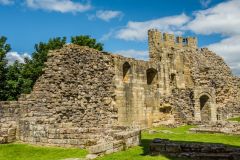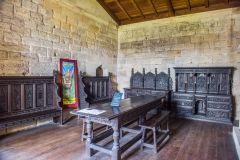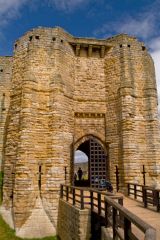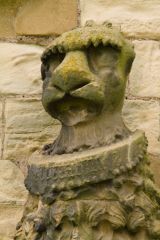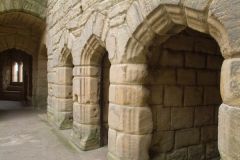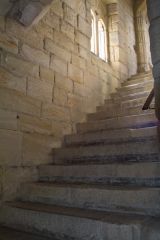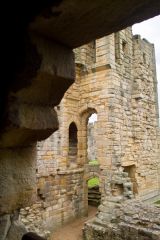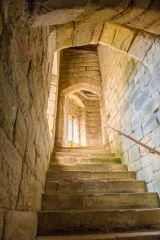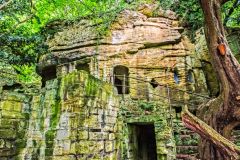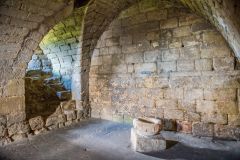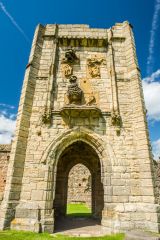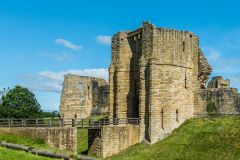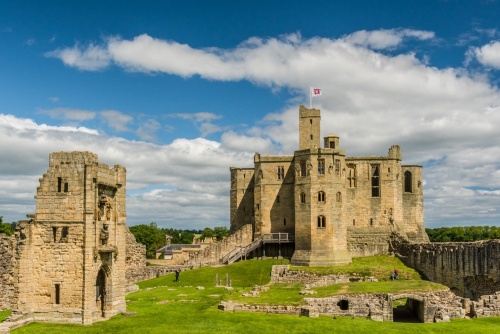
Warkworth Castle is a medieval fortress in a loop of the River Coquet, built by the powerful Percy family, Earls (and later Dukes) of Northumberland. Though the castle we see today dates to the 14th century there has almost certainly been a fortification at Warkworth at least as early as the Iron Age. There was a high-status residence here by the 9th century when Osbert, King of Northumbria, gave the estate to the Earls of Northumbria.
History
We do know that in the middle of the 12th century a motte and bailey fortification was erected in the loop of land, defended by timber walls. Though we know the 'when', we do not know the 'who'.
David I of Scotland took advantage of the civil war in England between King Stephen and Empress Matilda to capture large areas of Northumberland. His son, Henry, may have built the castle to defend his newly-won territory from English castles at Bamburgh and Newcastle. Alternatively, it may have been erected by Henry II of England after he took back Northumbria in 1157.
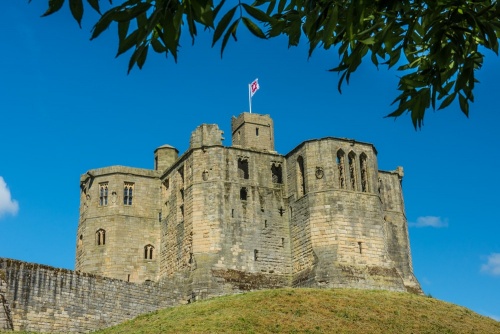
It was probably in a poor state by 1174 when William the Lion of Scotland captured Warkworth and slew the inhabitants. It was not until 1199 that Robert fitz Roger rebuilt the castle in grand style. Fitz Roger did not stint; he laid out the imposing stone fortress we see today, with a strong gatehouse defending a curtain wall.
He probably began the Great Keep atop the earlier castle motte. By 1213 Warkworth Castle was sufficiently finished - and finished in sufficient style - to play host to King John.
Warkworth Castle played a major role as a border fortress in the Scottish Wars of Independence in the early 14th century, when Scottish raiders struck deep into English territory. The castle was besieged in 1327 and the Scots returned to burn the town in 1341.
The Percy Connection
In 1328 Edward III granted Warkworth Castle to Henry de Percy of Alnwick, beginning a connection with the powerful Percy family that would last centuries. Henry's descendant, also named Henry Percy, moved the family's main residence from Alnwick Castle to Warkworth. He built the Great Keep to mark his elevation to the Earldom of Northumberland. He may have also built the gatehouse that controlled access to the town bridge.
The next few centuries saw Warkworth taken and retaken, seized by the Crown and restored to the Percys time and time again.
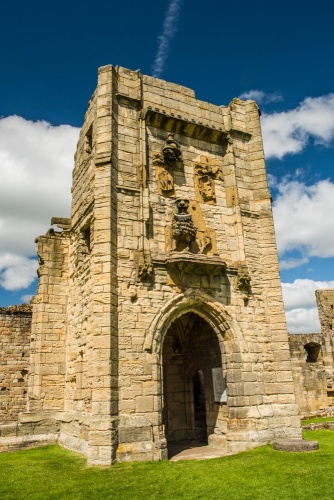
From 1405 the Earl and his son Henry 'Hotspur' Percy rebelled against Henry IV and Warkworth was seized by the Crown. Henry V restored the Percy estates in 1416. Subsequent Earls fought and died in support of the Lancastrian cause in the Wars of the Roses. The Yorkist general, Richard Neville, Earl of Warwick, besieged and captured Warkworth Castle and used it as his northern headquarters.
The Percy estates were restored by Edward IV but Warkworth was taken into Crown hands again in 1537 only to be restored by Mary I in 1557. In 1569 Thomas Percy, the 7th Earl, rebelled against Elizabeth I and Warkworth was once more taken into Crown hands.
It was restored after the Earls execution in 1574 but by this time the once-mighty fortress was in a state of decay. When the crowns of England and Scotland were united under James I and VI in 1603 the castle was no longer necessary to defend the border.
Two years later in 1605 Henry Percy, the 9th Earl of Northumberland was implicated in the Gunpowder Plot. He was imprisoned in the Tower of London and fined the huge sum of 30,000 pounds. To help pay the fine Percy leased Warkworth Castle to Sir Ralph Grey of nearby Chillingham Castle.
Sir Ralph did little to maintain the castle and by the outbreak of the Civil War it was considered ruinous. Nevertheless, it was garrisoned by Royalist troops twice. When they were ousted on the second occasion in 1649 Parliament had the castle slighted so that it could no longer be used for military purposes. Stone was later robbed from the castle for use on other local building projects.
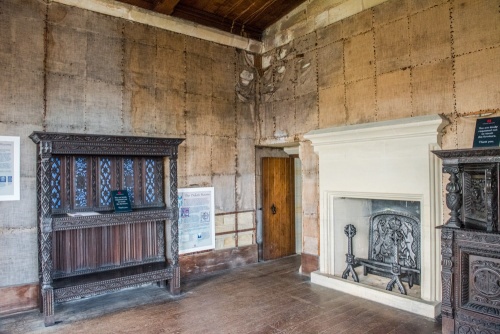
What to See
Despite the depredations of Parliament and the passage of time, Warkworth Castle is impressive.
The Great Tower
The most impressive feature at Warkworth is the 14th-century Great Tower, commissioned by the 1st Earl of Northumberland in 1377. English Heritage calls the Great Tower 'a masterpiece of medieval English architecture' and it is hard to argue with that. It was here in the early 15th century that Henry Percy and his son 'Hotspur' plotted treason against Henry IV -- treason that would result in both of their deaths.
The tower is laid out as a Greek cross, with polygonal wings springing from a central block. A slender tower rises above the central block. The clever design places a light well at the centre, extending through all three storeys to provide light to all the inner chambers.
The Great Tower may have been designed by John Lewyn, the same master mason who worked on Durham Cathedral. It is also similar to elements of Windsor Castle and Kenilworth Castle. The medieval tower was restored by architect Anthony Salvin in the Victorian period.
What makes the Great Tower so remarkable is that the interior is laid out with chambers of different sizes and heights, interconnected by a series of wall stairs, yet the exterior of the tower shows no hint of the ingenious layout within the walls.
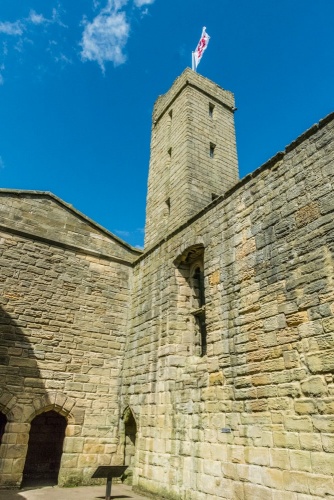
The Lion Tower
This striking tower acts as the impressive entrance portal to the hall range. It was built in 1480 by the 4th Earl and takes its name from the oversized sculpture of a lion, the symbol of the Percy family, over the entrance.
The design also incorporates symbols of the Lucy family and the Herbert family, both connected to the Percys by marriage. Look for another example of the Percy Lion on the external face of the Earl's bedchamber in the north tower.
Inside the hall range is the great hall, where the castle household gathered for meals and where business was transacted. Withdrawing chambers for the lord and his family are connected to the hall. Off the hall are a pantry, buttery and kitchen.
Also inside the bailey are the remains of a collegiate church built by the 4th Earl around the same time as the Lion Tower. The church was incomplete at the time of the Earl's murder in 1489 and was never finished.
The Curtain Wall and Towers
The impressive curtain wall encircles the castle bailey. The oldest parts of the wall date to the 13th century. In the south-wet angle of the wall is the Carrickfergus Tower, also built in the 13th century.
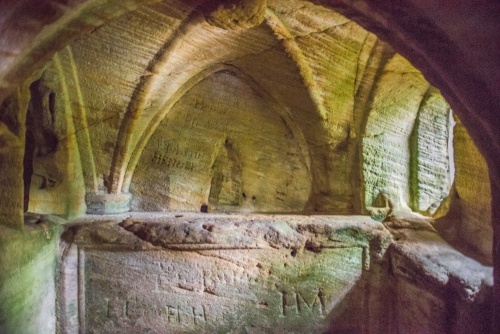
Other surviving towers include the Grey Mare's Tail Tower, built in the 1290s, and the Montagu Tower, built in the middle of the 15th century to provide extra accommodation for the Earl's family. The impressive gatehouse is one of the earliest parts of the castle. It was erected in 1200 and boasts polygonal towers flanking an entrance arch. The gatehouse is reached by a bridge over a dry moat.
Ghosts at Warkworth
Perhaps it is not surprising that a castle with such a long history has its fair share of resident ghosts. One spectre is that of a young man, seen running along the parapet walk. While the identity of the young man is unknown, the same cannot be said for another ghost called the Grey Lady, who is said to be Margaret Neville. The Grey Lady is usually seen in one of the castle towers.
NB. For those of a nervous disposition, I can say that we've visited Warkworth Castle three times and have yet to encounter anything remotely ghostly in our explorations.
The Hermitage
On the far bank of the River Coquet is a medieval chantry chapel hewn from the solid rock of a cliff face. The Earls of Northumberland hired a priest, or 'hermit' to say mass for their souls and those of their families.
The Earls could watch religious services from a second chamber, or sacristy, dug even further into the rock face. The Hermitage can only be reached by boat and has a separate admission fee from the castle itself.
About Warkworth Castle
Address: Castle Terrace,
Warkworth,
Morpeth,
Northumberland,
England, NE65 0UJ
Attraction Type: Castle
Location: 7 miles south of Alnwick, on the A1068
Website: Warkworth Castle
English Heritage - see also: English Heritage memberships (official website)
Location
map
OS: NU247 057
Photo Credit: David Ross and Britain Express
HERITAGE
 We've 'tagged' this attraction information to help you find related historic attractions and learn more about major time periods mentioned.
We've 'tagged' this attraction information to help you find related historic attractions and learn more about major time periods mentioned.
Find other attractions tagged with:
14th century (Time Period) - castle (Architecture) - motte and bailey (Historical Reference) - Norman (Architecture) -
NEARBY HISTORIC ATTRACTIONS
Heritage Rated from 1- 5 (low to exceptional) on historic interest
Warkworth, St Lawrence Church - 0.3 miles (Historic Church) ![]()
Warkworth Castle Hermitage - 0.4 miles (Historic Church) ![]()
Alnwick Castle - 6.1 miles (Castle) ![]()
Bailiffgate Museum, Alnwick - 6.2 miles (Museum) ![]()
Alnwick, St Michael's Church - 6.3 miles (Historic Church) ![]()
Alnwick Abbey Gatehouse - 6.7 miles (Abbey) ![]()
Howick, St Michael's Church - 7.2 miles (Historic Church) ![]()
Howick Hall Gardens - 7.3 miles (Garden) ![]()
Nearest Holiday Cottages to Warkworth Castle:
Warkworth, Northumberland
Sleeps: 4
Stay from: £328 - 1688
More self catering near Warkworth Castle
